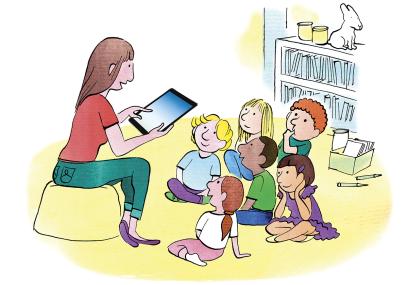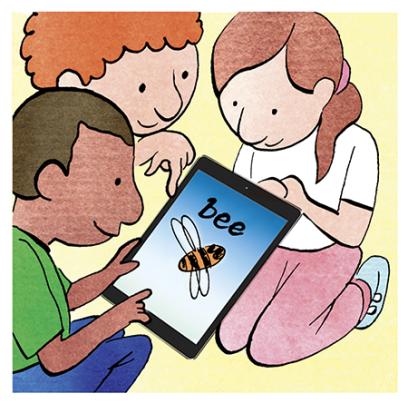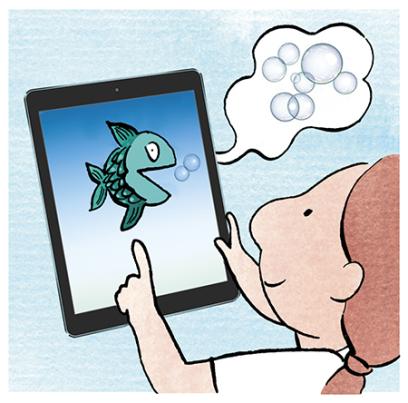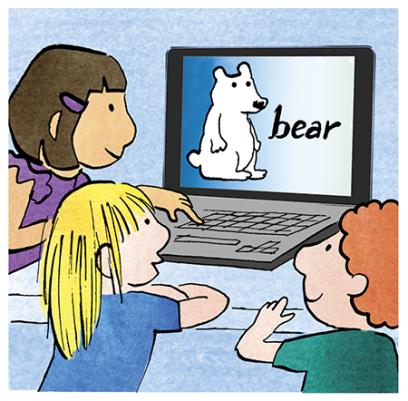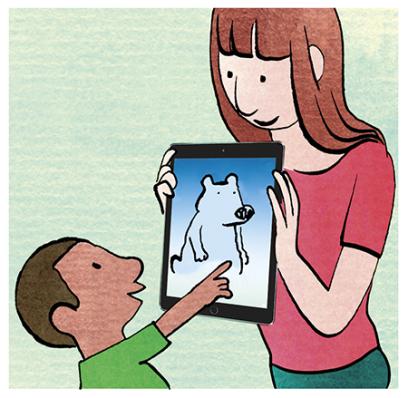One morning this spring at Aldersgate KinderPrep in Chesapeake, Virginia, four kindergartners were clustered around an iPad. With their small fingers, they tapped away on a series of apps designed around Mercer Mayer’s classic Little Critter books, including well-known titles such as All by Myself and Just Grandma and Me, with their porcupine-like characters with scruffy hair and big cartoon eyes. Carla Bell, the center’s director, sat with the children to observe.
Bell recalls being amazed at how engrossed they were. The kids would touch on a character or a picture, and the app’s audio would tell them the corresponding word. “The kids love to touch the pictures,” Bell said. In fact, she added, “they love to do that a lot.” Soon she found, to her dismay, that the children were spending most of their time hearing one word over and over: “critter, critter, critter, critter.”
“I learned from that mistake,” Bell said. When she grouped the kids around her the second time, she inserted herself as a guide: First, let’s listen to the whole story without using the app’s interactive elements, she told them. “Then,” she said, “we’ll go back and we can touch on the words and the pictures.”
Young children today are gaining access to a dizzying array of apps, games, and videos. With all of this digital media at their fingertips, two urgent questions have emerged in preschools and elementary schools: Could technology interfere with the way children learn to read? Or could it help?
As brain science shows, the act of reading is not a given for human beings. Maryanne Wolf’s landmark book Proust and the Squid: The Story and Science of the Reading Brain has helped us understand that our brains do not automatically pick up reading the way we, from our very earliest days, start to pick up spoken language. Instead, the brain has to be trained to read. What kind of training are today’s children receiving? Might some young children be experiencing an environment that puts them at a real disadvantage?
These are questions that have animated our teams at New America and the Joan Ganz Cooney Center over the past three years, as we’ve studied the impact of digital technology on learning and, more specifically, on the teaching of reading. Our research, chronicled in our book Tap, Click, Read: Growing Readers in a World of Screens, has prompted us to advocate for a significantly different approach that could help replace the status quo and that tackles the worrisome prospect of increased disparities across socioeconomic groups in this country. In short, our answer is to start much earlier in children’s lives with high-quality early education, apply the lessons from the new science of learning, and bring in a “third way” approach to using technology.
Laying the Foundation for Literacy
Today, more than two-thirds of American students are struggling to comprehend what they read. This statistic, derived from test results from the fourth-grade National Assessment of Educational Progress, is even more sobering when we recognize that these numbers have barely budged for more than 15 years, and billions of dollars have been spent on educational reforms to no avail.1 For students in underserved populations, such as low-income families, as well as among Hispanics and African Americans, the percentage of students who are not proficient readers reaches up to 80 percent.2
Conventional wisdom tells us that focusing on the basics—letters, sounds, and stories—during the ages of 4, 5, and 6 is the surest way to teach youngsters to read. But new findings from the learning sciences show that becoming a reader is not something that is simply activated during a few years in primary school.3 The skills that promote strong reading are developed within the brain much earlier. In fact, the foundation for becoming a truly literate person—one who not only comprehends the written word but also listens, writes, speaks, and communicates knowledgeably about content and ideas—is built much earlier too.
The precursors of reading begin in infancy, as very young children begin to develop language skills and a growing awareness of how the world works. Children’s brains are primed to learn how to speak, listen, and communicate via their back-and-forth interactions with adults and peers. This involves parents and caregivers talking to babies even before they have the words to respond, and answering their gestures and coos with understanding and elaboration. The more those conversations introduce new words and ways of explaining the world around them, the better: “The flowers are budding. See the petals?” or, “Abuela knitted this little hat for you. It has the same zig-zag pattern as your sweater!”
Once they enter preschool, children are ready for more specific emergent literacy skills. This is where scientific consensus has formed around a two-pronged, skills-plus-knowledge strategy for learning to read: children need exposure to letters, sounds, and the “decoding” of written words while also being immersed in stories and interactions that introduce them to the multilayered worlds of science, art, history, literature, different cultures, and more. They need skills and knowledge. This two-pronged strategy, most experts agree, should be at the heart of literacy learning everywhere.*
With this growing knowledge of the early years, it makes good sense to advocate for deeper and smarter investments in infant and toddler programs, parenting workshops, preschools, elementary schools, libraries, and teacher preparation. Children’s language development and reading scores would certainly benefit. But here is where the conclusions from our research take a more controversial turn: more investment in early childhood will not be enough unless it is coupled with a strategy that recognizes the challenges and opportunities of the digital age. The fact is that children are surrounded by technology and media these days. Reports from the Joan Ganz Cooney Center, Common Sense Media, and the journal Pediatrics show that, even in low-income families, toddlers and preschoolers are using smartphones and touchscreen tablets on a regular basis.4
How do we ensure that this now-ubiquitous technology is harnessed to assist in promoting the two-pronged strategy for learning to read, instead of undermining it? How might digital media be used in service of conversation and rich adult-child interactions, instead of being dismissed as a barrier to those interactions? Today’s preschoolers will make up the high school class of 2030, a class of students who will have grown up in a digital world and who will need an even stronger foundation in literacy than many adults have today. Educators and parent-engagement specialists will need answers to these questions if they are going to make a dent in the distressing rates of low reading proficiency among these children and help develop a generation that can thrive in the 21st century.
Understanding Why Disparities Persist
In this magazine four years ago, Susan B. Neuman and Donna C. Celano published an article titled “Worlds Apart: One City, Two Libraries, and Ten Years of Watching Inequality Grow.” It was based on a study they conducted in two Philadelphia libraries, one located in a community of affluence and the other in an economically distressed part of the city. For nearly a decade, they and their research assistants sat in the two libraries, carefully observing how parents and children used the books and computers within. Even though one of the libraries was in a low-income area, it provided the same level of offerings of books and computers, due to the generosity of a local funder who wanted to level the playing field and give disadvantaged families the same learning opportunities as more well-off Philadelphians.
And yet, as Neuman and Celano recounted, the disparities did not go away. The presence of computers did not suddenly give adults and their children a leg up. In the economically distressed community, Neuman and Celano saw example after example of adults with only rudimentary technology skills struggling to fill out forms or work with new software after waiting in line for their allotted 30 minutes at a computer station. They saw children looking at picture books in short bursts, with few adults around them to guide them through stories and ask them questions. They saw kids playing with computer games that took them off on tangents that had little to do with reading stories or learning new skills, or that were not designed to help them gain confidence or make progress, leading to the pounding of keyboards, frustration, and eventually giving up.
Meanwhile, children at the other library were using computers with an adult by their side, one who had the technological expertise to guide them to appropriate games and early literacy software, not to mention the time to ask them questions about what they were playing with. Not only were these children benefiting from conversation and an introduction to new skills, they were absorbing information about how computers work and how to use them to gain knowledge and solve problems.
The story of these Philadelphia libraries is now playing out across the country in libraries, schools, and households everywhere. Low-income families and high-income families are tapping into technology at a high rate.
In a recent national survey by the Cooney Center of nearly 1,200 low-income families, more than 90 percent had access to the Internet via a mobile device, and 8 in 10 owned a smartphone with a data plan.5 But access to phones and apps is not a panacea. Without recognizing what families really need—without more guidance on the importance of adult-child interactions around media use—technology adoption could widen the gaps between families with high levels of education and technology know-how, and families who have very little of either.
One reason for worry emerges from the marketplace where parents and educators are increasingly casting about for help: online app stores. In 2012 and 2014, our teams at the Cooney Center and New America scanned the app stores to learn how early literacy apps are marketed and what features they offer. Our effort, led by Sarah Vaala of Vanderbilt University and Anna Ly, a research fellow and business development expert based at the Cooney Center and Sesame Workshop, analyzed nearly 200 apps targeted to children ages 0–8, with emphasis on early literacy and the top 50 most popular apps in the education sections of those stores. We discovered that few apps were labeled to help parents find particular products for particular ages. Instead, they were often vaguely described as being for “young children,” not recognizing there is a large difference between the needs of a 3-year-old and the needs of a 6-year-old.
We also found very few matches between apps that rise to the top as “most popular” in the app stores and apps that are praised by experts at review sites like Common Sense Media, Parents’ Choice, and Children’s Technology Review. Many of those experts, for example, put a premium on creativity and storytelling, but those kinds of apps are rare in the “most popular” lists in app stores.
The types of skills emphasized by the apps were also problematic. For example, among free apps, more than 50 percent focused on teaching children to recognize the letters and sounds of the alphabet, while less than 10 percent of free apps focused on reading comprehension, and even rarer were skills like reading fluency (the ability to read without stumbling over certain words) and self-expression.
Another cause for worry comes from confusing messages about how to use media from the experts themselves. For many years, parents and teachers have heard warnings from the American Academy of Pediatrics and other health-related organizations that emphasize the dangers of children consuming media at the expense of social interaction.6 The image of a child looking at a screen evokes handwringing and concern: Those poor kids, say the worriers. They are so isolated, addicted, their brains turning to mush. Some parents, often those in middle- to upper-income demographics, brag that they have never “exposed” their children to a screen.
School- and districtwide adoption of new learning technologies has not gone swimmingly well either. In the Los Angeles Unified School District, for example, educators and families were treated to a debacle regarding tens of thousands of expensive yet unused devices.7 And research scientists such as Larry Cuban at Stanford University have presented studies with disappointing results showing the unfulfilled promise of technology integration to drive innovative, effective instructional reforms.8 In our observation, most early learning centers and elementary schools are still struggling to sort out how best to deploy research-informed practices in reading blocks within the pre-K to third-grade years.
Technology Can Help
Despite these challenges, more than a decade of studies on audiovisual media with young children are also painting a nuanced picture about the conditions under which technologies do, in fact, help. Researchers are finally coming to recognize that digital media are not some monolithic force. There are all sorts of different types of media and different ways of using technology. The content on the screen, the context of how it is used, the way individual children respond to the media, and the communities in which children and families use media—all of this can make a huge difference.
For example, studies show that if the screen is blaring away with background noise or adult-oriented content, toddlers and preschoolers suffer. Background television, and other background media, interfere with conversations with parents and disrupt young children’s playing time, which is becoming understood as a key ingredient for their development.9
On the other hand, numerous studies have shown that children at very young ages can gain important skills in literacy and language development if the content on the screen is designed for learning.10 That learning is accentuated and deepened if they have a parent or educator who is using the media with them, talking about what they are doing and seeing. Add in the ways that media might augment the values and assets within long-standing family ties and cultural traditions, and the learning potential grows stronger still. Studies from the Cooney Center with Hispanic-Latino families, for example, have shown that Spanish-language and English-language educational media are rich sources of conversation and learning across generations.
This new research is getting noticed, and the result may be less confusion and more helpful messaging to families in the near future. In October 2015, for example, the American Academy of Pediatrics announced that it would be making changes in the next year to its recommendations on how children use screen time. Representatives from the academy have called for new guidance that is less about avoiding media at all costs and more about guiding parents and teachers to use it to help children learn.
Even before that, the nonprofit organization Zero to Three released the report “Screen Sense,” providing a new set of guidelines for parents and caregivers of infants and toddlers that takes a similar approach.11 And the U.S. Department of Education is planning to publish a document that synthesizes those findings and more from new research on how to use media in healthy and learning-focused ways.
In the meantime, many educators like Carla Bell, the preschool director in Virginia, are experimenting with digital media out of a sense of both curiosity and obligation to help more children learn using whatever tools they can find. Already, Bell’s experience with the digital “Critter” books has helped her realize that handing children e-books may not be enough. Her center enrolls children from ages 2½ to 5. Teachers of children that age should know how to walk them through a print book, pausing to ask questions and “scaffolding” children’s learning based on what they already know. In the same way, Bell decided that she needed to guide and become more involved with the kindergartners as they used the story app. “I found that if I didn’t do that,” Bell said, “we never got through the story.” Plus, she said, “I also made the mistake of telling them, ‘You can find the spider guy and lizard guy,’ ” two little hide-and-seek activities that are part of the story app, “and then they did, and they weren’t paying attention to the print.”
Digital media and literacy do not have to be on this collision course. We should be doing everything we can to enable a shift: media should be used in service of literacy, and our notions of literacy have to evolve to help children master the skills needed to make sense of all kinds of media. If the question is, Can technology help today’s media-immersed children learn to read?, our research over several years tells us the answer is yes—if they are surrounded by adults who know how to help, and introduced to media designed to promote literacy instead of undermining it. We need a third way: a new approach that is human-powered first and tech-assisted second.
Fortunately, there are many new models to show how this could work. In addition to our study of the app stores, our research on technology and literacy has led us to discover the emergence of dozens of new initiatives that employ technology in early literacy learning. These models (some of which are discussed in the sidebar on the right) are springing up around the country in early learning centers, home-visiting and family support programs, libraries, and schools. They begin by recognizing that learning starts with the power of the adult-child relationship and then use technology to augment, assist, and provide support and guidance for those relationships.
Learning through Trial and Error
Across all of these human-powered, tech-assisted innovations, however, many challenges still exist. Several educators we’ve interviewed say they wish they had more time to try out new tools, critique apps and e-books, and adapt them to the needs of their particular classrooms. Others are trying to make sense of more “personalized” learning platforms that may help them vary instruction for their students. They are doing all this at the same time that they are expected to learn new standards, acclimate to new assessments, and do a better job of tuning into the special needs of children from a plethora of different backgrounds.
Ironically, then, making good on the promise of technology will mean changing routines to become truly human centered. It will require recognizing and adapting to the learning needs of the teachers, principals, and parents as much as those of the children.
This past spring we witnessed what this might look like. At the Highlights Foundation’s rural Pocono Mountains retreat in Pennsylvania, about half a dozen public school teachers and several librarians arrived for a small two-day forum with e-book and app developers and education researchers. The forum, part of a series of annual meetings titled “Dust or Magic,” was designed by Warren Buckleitner, editor of the Children’s Technology Review, who has lamented for years that these kinds of matchups are stunningly unusual. He clearly has hit on a winning combination. The educators were thrilled to talk to each other, reflect on their teaching strategies, and play with new tools. And the app developers were excited to hear from working educators.
A headliner for the conference was Kate Wilson, the managing director of Nosy Crow, a company based in the United Kingdom that creates story apps that get high marks from reviewers such as Buckleitner. Instead of simply showing the educators her company’s story apps, which make creative use of public-domain fairy tales like “Goldilocks” and “Jack and the Beanstalk,” Wilson gave them a behind-the-scenes look at how the apps are made and what decisions drive their design. Then she asked for their feedback: “Does this work?” she asked.
“I teach a unit with fairy tales, and we teach new versions all the time,” piped up Denise Panza, who teaches first-graders at Stourbridge Primary Center in Honesdale, Pennsylvania. “To be able to have this to show different versions—what a cool tool.”
Wilson probed further. In the Goldilocks app, readers can experience the story in two different ways, simultaneously. Click on Goldilocks, and you experience the story from her point of view; click on the bears, and you see theirs. The story is set up so that readers can also toggle back and forth at any time, moving from the bears’ scene to Goldilocks’s, and vice versa. During one of these scenes, children can also click on the bears as they are eating porridge at their breakfast table, which activates a conversation among all three bears.
Wilson wanted to know what the educators thought about the way the scene was set up. All this clicking for conversation: Was it too much? Or does it help?
Marci Jones, another teacher at Stourbridge Primary Center, gave the feature a thumbs up. “Having the characters speak to each other—some of our kids aren’t getting that kind of discussion at the dinner table. That’s what I like about this,” she said.
Back in Virginia, Nosy Crow apps are getting a thumbs up from Carla Bell too. She said her KinderPrep children are just as click-happy with Nosy Crow apps as they are when reading the “Critter” books. But in the case of the Nosy Crow apps, “having the characters talk” was both captivating and helpful in getting the children to follow the story.
Regardless of the story app or e-book, however, Bell said she is learning what works through trial and error. For one, she has realized that educators need to understand they can’t just hand the kids the iPads. “I tell my teachers, ‘You’ll need to take this home first and play around with it.’ ” She also has come to recognize that while the apps can serve as what she calls a “teacher surrogate” when the teacher herself cannot be paying attention to every move, the presence of teachers and adults makes a big difference. “They got more out of it because I was there and could answer their questions,” she said.
For too long, the debate about technology in early childhood has focused on “screen time,” with an emphasis on how much time children are spending on screens instead of an emphasis on what they are actually doing with them. But now, with new efforts to explore the content on the screen and the context around it, educators and parents can start to jump over the polarizing debates and put energy into helping young students become literate across media of all kinds.
The American Academy of Pediatrics hit this nail on the head when it published its preview in October about why it was rethinking its screen time guidelines. “In a world where ‘screen time’ is becoming simply ‘time,’ ” the article said, “our policies must evolve or become obsolete.”12 The lines that used to define “screen time,” “learning time,” and “play time” have become so blurred as to be meaningless. Now it’s about how well we’re using our time and resources with children. Learning can happen via book or screen, or, in the case of e-books, both. Let’s address how learning can and should be happening regardless of the medium.
The children and families of the 21st century will grow up with screens and digital media everywhere. Educators and parents will need new models for how to use these tools to promote learning. Instead of pushing screens away, let’s put them into the hands of adults and children to use together to learn and grow. In using technology to help educate children, the class of 2030 needs all of us to embrace this third way.
Lisa Guernsey is deputy director of the Education Policy program and director of the Learning Technologies Project at New America. Michael H. Levine is a child development and policy expert and founder and executive director of the Joan Ganz Cooney Center at Sesame Workshop. They are the coauthors of Tap, Click, Read: Growing Readers in a World of Screens.
*For more on why reading comprehension depends largely on knowledge, see the Spring 2006 issue of American Educator. (back to the article)
Endnotes
1. Lisa Guernsey and Michael H. Levine, Tap, Click, Read: Growing Readers in a World of Screens (San Francisco: Jossey-Bass, 2015), 7.
2. U.S. Department of Education, National Assessment of Educational Progress (NAEP), 2015 Reading Assessment. Data on fourth-grade reading scores is available at www.nationsreportcard.gov/reading_math_2015/#reading/acl?grade=4.
3. Nonie K. Lesaux, PreK–3rd: Getting Literacy Instruction Right (New York: Foundation for Child Development, 2013); and Campaign for Grade-Level Reading, The 30 Million Word Gap: The Role of Parent-Child Verbal Interaction in Language and Literacy Development (Washington, DC: Campaign for Grade-Level Reading, 2013).
4. Victoria Rideout, Learning at Home: Families’ Educational Media Use in America (New York: Joan Ganz Cooney Center, 2014); Common Sense Media, Zero to Eight: Children’s Media Use in America 2013 (San Francisco: Common Sense Media, 2013); and American Academy of Pediatrics Council on Communications and Media, “Children, Adolescents, and the Media,” Pediatrics 132 (2013): 958–961.
5. Victoria Rideout and Vikki S. Katz, Opportunity for All? Technology and Learning in Lower-Income Families (New York: Joan Ganz Cooney Center, 2016).
6. American Academy of Pediatrics Council on Communications and Media, “Children, Adolescents, and the Media”; and Jenny S. Radesky, Caroline J. Kistin, Barry Zuckerman, et al., “Patterns of Mobile Device Use by Caregivers and Children During Meals in Fast Food Restaurants,” Pediatrics 133 (2014): e843–e849.
7. Issie Lapowsky, “What Schools Must Learn from LA’s iPad Debacle,” Wired, May 8, 2015.
8. Larry Cuban, Inside the Black Box of Classroom Practice: Change without Reform in American Education (Cambridge, MA: Harvard Education Press, 2013).
9. Tiffany A. Pempek, Heather L. Kirkorian, and Daniel R. Anderson, “The Effects of Background Television on the Quantity and Quality of Child-Directed Speech by Parents,” Journal of Children and Media 8 (2014): 211–222; Matthew A. Lapierre, Jessica Taylor Piotrowski, and Deborah L. Linebarger, “Background Television in the Homes of US Children,” Pediatrics 130 (2012): 839–846; and Marie Evans Schmidt, Tiffany A. Pempek, Heather L. Kirkorian, Anne Frankenfield Lund, and Daniel R. Anderson, “The Effects of Background Television on the Toy Play Behavior of Very Young Children,” Child Development 79 (2008): 1137–1151.
10. Daniel R. Anderson and Katherine G. Hanson, “What Researchers Have Learned about Toddlers and Television,” Zero to Three 33, no. 4 (2013): 4; Marina Krcmar, Bernard Grela, and Kirsten Lin, “Can Toddlers Learn Vocabulary from Television? An Experimental Approach,” Media Psychology 10 (2007): 41–63; Deborah L. Linebarger and Dale Walker, “Infants’ and Toddlers’ Television Viewing and Language Outcomes,” American Behavioral Scientist 48 (2005): 624–645; and John C. Wright, Aletha C. Huston, Kimberlee C. Murphy, et al., “The Relations of Early Television Viewing to School Readiness and Vocabulary of Children from Low-Income Families: The Early Window Project,” Child Development 72 (2001): 1347–1366. See also, Lisa Guernsey, Screen Time: How Electronic Media—from Baby Videos to Education Software—Affects Your Young Child (New York: Basic Books, 2012).
11. Claire Lerner and Rachel Barr, “Screen Sense: Setting the Record Straight; Research-Based Guidelines for Screen Use for Children under 3 Years Old” (Washington, DC: Zero to Three, 2014).
12. Ari Brown, Donald L. Shifrin, and David L. Hill, “Beyond ‘Turn It Off’: How to Advise Families on Media Use,” AAP News, October 2015.

